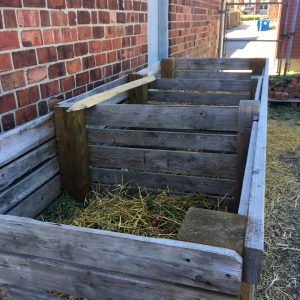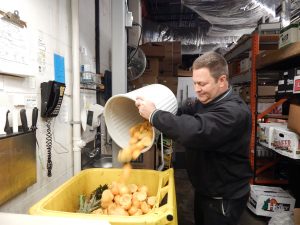Fight Food Waste, Fight Climate Change!
Food waste has a direct link to climate change. Learn how to combat climate change with composting by reading below!
What happens to food in a landfill?
Americans throw away nearly half of all their food, equaling around 150,000 TONS of wasted food EVERY DAY. When food waste goes to the landfill, it decomposes without air, creating methane. 150,000 tons of organic material per day creates a lot of methane.
Methane is greenhouse gas that is anywhere from 34 to 86 times as potent as CO2. (The difference in potency depends on time – methane is a much stronger greenhouse gas during a twenty year time span – after 20 years its warming potential declines). Methane can come from a variety of sources: cow burps, oil and gas production, some natural habitats like wetlands, and landfills. Landfills create about 12 percent of the world’s total methane.
Many people assume that when things go to a landfill, they decompose as they would in the environment. In reality, landfills store our waste – they don’t break it down! It can take a head of lettuce 25 years to break down in a landfill! Landfills are layered with material to prevent garbage from blowing away, and they are eventually covered or capped to protect neighboring communities from contaminated air and the slurry created by co-mingled trash. This means the material in a landfill is not exposed to air and water – conditions that are necessary for healthy decomposition of organic material.
The problem of food waste in landfills is serious, but there is good news: methane emissions coming from landfills is a solvable problem. We can prevent food from going to the landfill through several strategies, like buying only what you need, buying “ugly food,” eating local, and finally, composting.
Composting is an easy way to keep your veggie scraps, egg shells, and coffee grounds from going to the landfill, preventing methane from entering the atmosphere and creating healthy soil. There are tons of great resources available if you’d like to start composting, whether you want a tumbler, a three bin system, a vermiculture bin, or a simple pile!
What about restaurants?
Restaurants can have a tougher time than homeowners do when composting, due to the volume of scraps they create and the multiple staff people that need to be trained. Once the process gets going, though, restaurants who compost tell the Green Dining Alliance composting is a snap.
Some GDA restaurants have urban farms, and are able to compost their veggie scraps on their own property using a traditional three-compartment system, like the one pictured below.

Others use a commercial composter, Total Organics Recycling, to handle their food scraps. Commercial composters can take food scraps that cannot be composted in a backyard or three-bin system – they accept items like bones, meat, dairy products, customer food scraps, and even compostable cutlery and straws, transforming them into useful compost. According to Total Organics Recycling, composting at an average restaurant takes the equivalent of 3-4 cars off the road!

Composting is a small step with big impacts. Consider composting at home, asking your favorite restaurant if they’re composting, and, if they are, be sure to thank them for doing their part to reduce greenhouse gas emission in our region!




